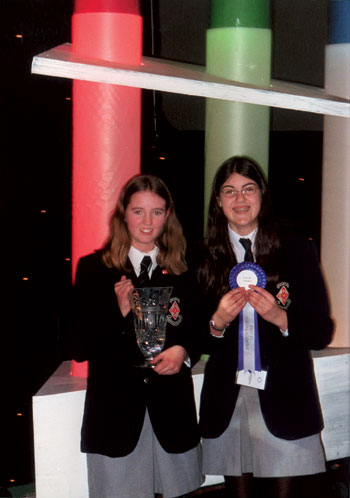| 2003 |

|
YEAR BOOK |
Midleton College, Cork
|
How can we balance our carbon emissions?
|

We wondered whether trees could take in this excess carbon as they use carbon dioxide while making their food. To do this, we measured the amount of new growth in a sample of young trees. We measured three different species, hawthorns, ash, and willows.
To find the new growth, we measured the length of each twig from the most recent scale leaf scar (these are rings on the bark that mark where the new growth has started each year) and the diameter at the scale leaf scar. To find the volume of new wood in the stem we measured the length and diameter of the wood between the scale leaf scars down the stem. We took samples of stems of various diameters and measured the diameter of each of these and the diameters of their most recent tree rings. We put this on a graph and read off the diameters of the most recent tree rings for the stems we had measured.
We calculated the total volume of new growth in each tree. Using a set rate for hardwood trees, we worked out how much carbon was in these volumes. Then we averaged each species. We divided these by the volume of carbon emitted in Ireland in one year, giving us the number of trees needed to be planted to balance carbon emissions. There is not enough land in Ireland for this. We concluded that Ireland should emit less carbon.
Though we got an accurate enough answer, if we were to do this project again we would have to go around to different parts of the country and measure trees in different climatic conditions. Also we would have to measure more trees to help get a more accurate figure. Another point would be that older trees absorb more carbon than younger trees because they put on more carbon per year.
R�is�n Stronach & Harriet O'Rourke entered their project in the Junior Group Section in the Biological and Ecological Sciences Category at the Esat BT Young Scientist & Technology Exhibition in January 2003. They won a Special Award sponsored by Met �ireann.
Their teacher was Ms Louise Curtin.
|
|